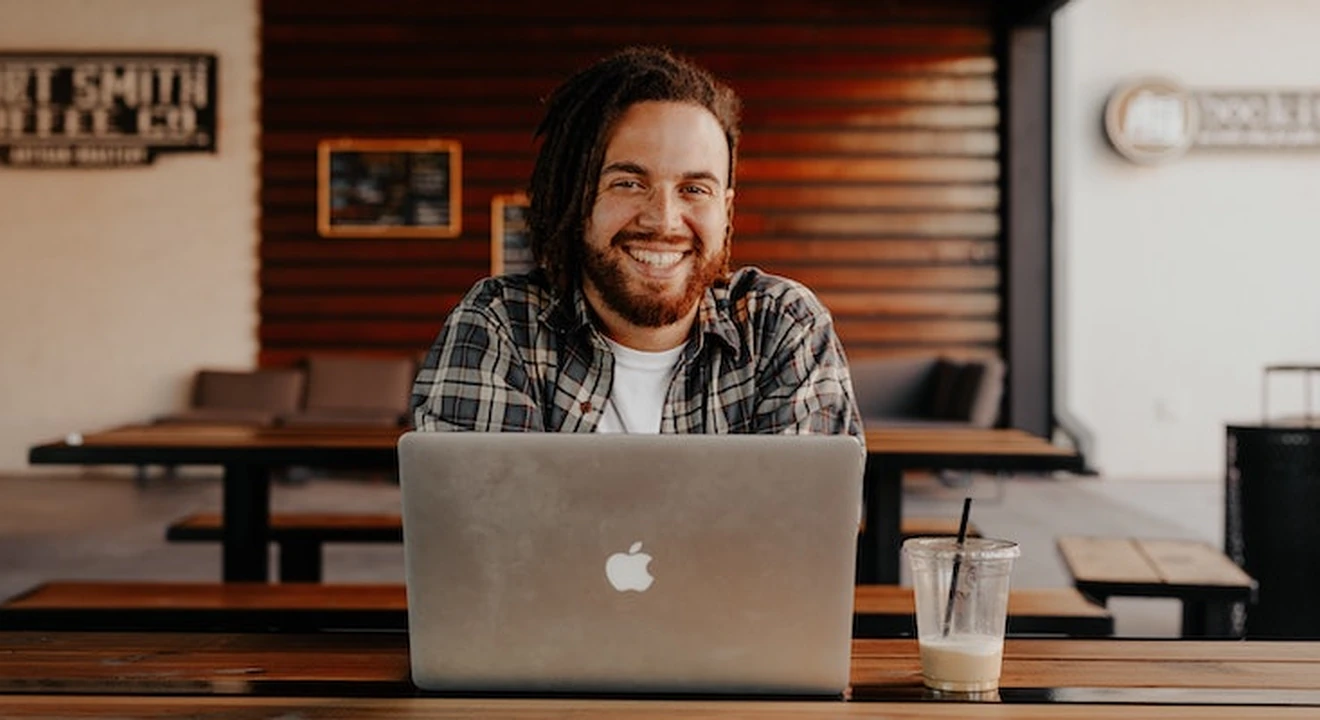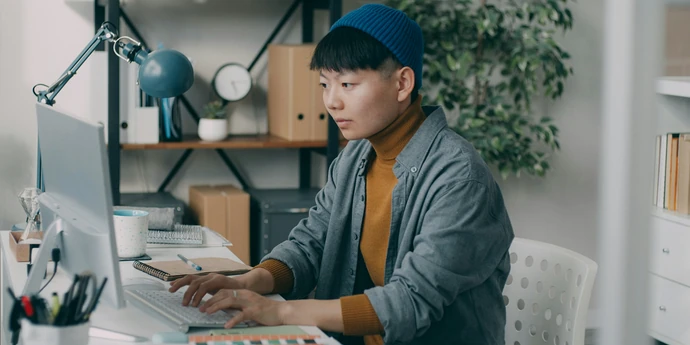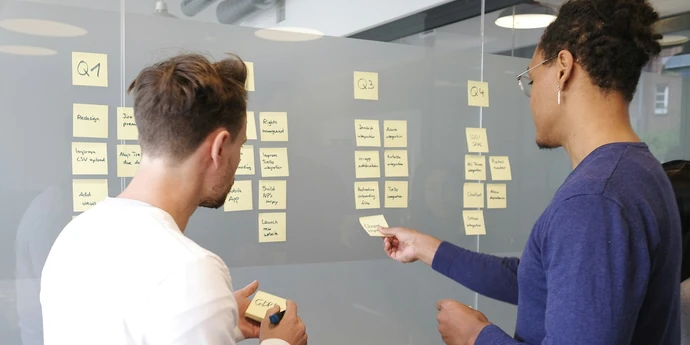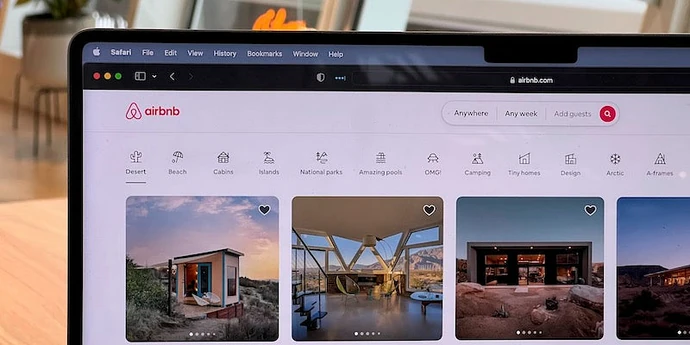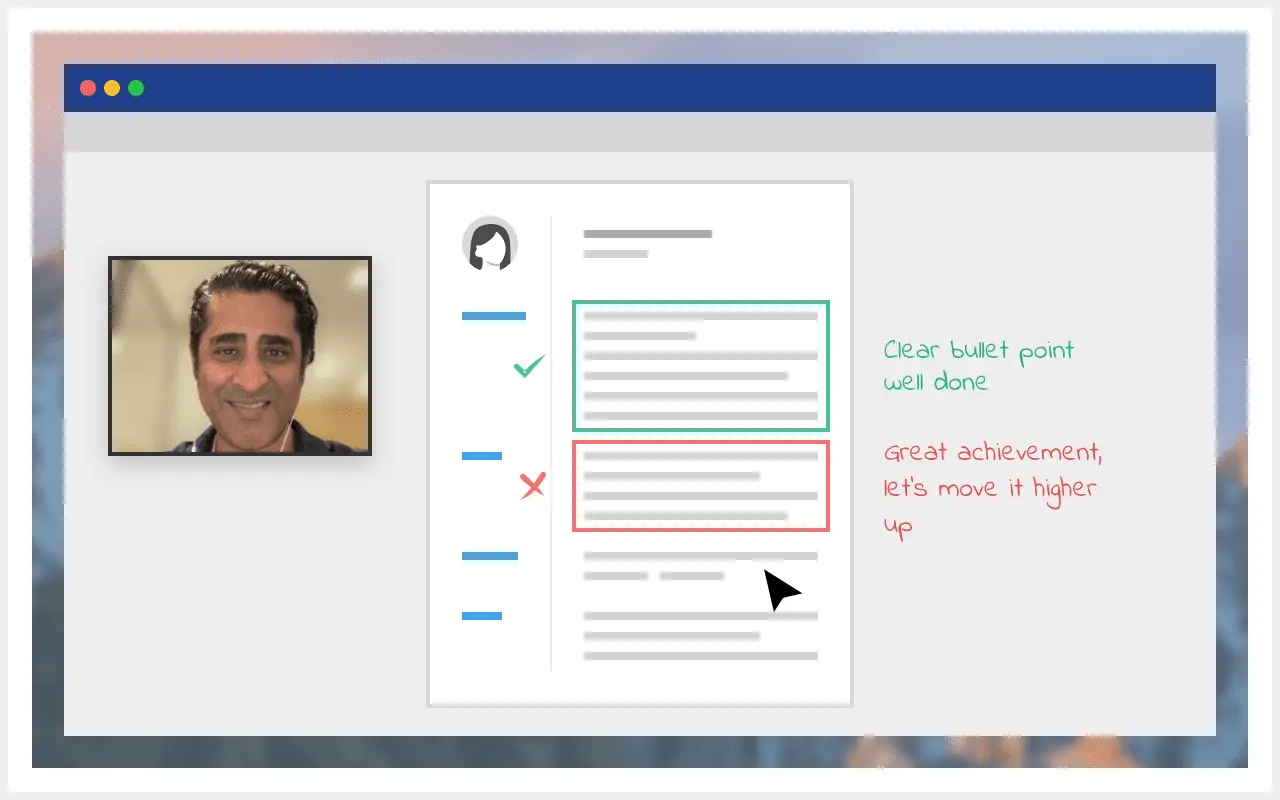Product Management is a hot field. Companies such as Google, Meta, or Amazon, routinely receive 300+ applications for a single position.
To increase your chances of getting that PM interview, use our step-by-step guide to writing a top product manager resume.
As well as tips and expert insights, it includes 12 REAL EXAMPLES of resumes that won product manager candidates offers or interviews at Google, Meta, Amazon, and elsewhere.
Yes, twelve actual resumes that real product managers used to get offers (unlike the fake, generic ones you find on the big resume sites).
Plus, we also analyzed product manager job offers at top companies to create a list of common requirements that your PM resume will need to meet.
Here’s an overview of what we’ll cover:
2. PM resume examples that worked for Google, Meta, Amazon, Uber, etc
3. Product manager resume template (downloadable)
4. Product manager resume tips (from top recruiters)
5. How to write a product manager resume (section-by-section)
6. Your product manager resume checklist
Let’s get into it.
Get expert feedback on your resume from an ex-FAANG product manager
1. Defining your PM skillset
Before you start writing your resume, you need to think about the type of product manager you are or want to be.
Don't yet have any product management experience? See our guide on how to transition into product management (from any role or experience level)
In recent years, the product manager role has become increasingly specialized, with positions such as “Growth PM" or “Data PM” now common. After all, at a large company, it’s simply impossible to be the “know-everything” type of PM that can exist at smaller companies.
The excellent article “The Growing Specialization of Product Management” by Reforge outlines 4 PM specializations:
- Core PMs, who focus mostly on product feature work and are sharply focused on solving customer pain points. If you’re early into your PM career, you are probably a Core PM.
- Growth PMs, who focus on improving the business metrics that determine a product’s success: acquisition, CAC, sign ups, free trial starts, conversion/purchase rates, monetization, ARPU, and retention.
- Platform PMs, who focus on internal customers (e.g. engineering, operations, etc.) and scaling internal platforms and services for continued organizational growth. Most Infrastructure and Data PMs would be in this category.
- Innovation PMs, who focus on identifying and experimenting with new opportunities to reach and expand product market fit.
It's worth thinking carefully about the type of product manager you want to position yourself as, as this will influence which skills you focus on and which achievements you highlight. We'll come back to this in Section 2.
1.1 PM skills
As we discussed above, different kinds of product managers will have strengths and weaknesses in different areas. However, all PMs will typically include a mix of technical (“hard”) skills and soft skills.
Let’s step through the most important competencies in each of these two categories.
1.1.1 Technical ("hard") skills
Product development follows a standard life cycle:
- Identifying and planning a product opportunity
- Designing the product
- Building it
- Launching it to market
- Assessing its success to be able to iterate
Product management recruiters will be looking for candidates who demonstrate skills relevant to these five life cycle phases.
While deep knowledge in every skill area is unrealistic, even for a senior product manager, you should probably aim to touch on most if not all these skills in your resume to make sure you check off all the recruiter’s boxes.
- Strategy skills, such as carrying out user or market research, identifying and solving customer problems in past jobs, or even simply writing a strategy memo or presentation.
- Design skills to show that you have a good enough eye for UX and UI to be able to give constructive feedback to the design team. This can mean you’ve worked with designers in the past and are used to providing feedback on UX wireframes or UI mock-ups for projects, as well as using tools such as Sketch and Figma.
- Engineering skills to show you will understand how the engineering team will build the product and act as their voice when liaising with marketing, design, etc. List any computer science or coding experience, even if minor. Having worked with engineering teams in the past is also great to mention.
- Digital marketing skills to show you can help the marketing team launch the product. Mention any relevant experience such as writing blog posts, designing digital paid ads, running social media channels, etc.
- Data analytics skills to show you can assess product success and iterate. List examples where you have set success metrics, analyzed reports, or written reports for stakeholders. Also include using tools such as Excel, SQL, Python, and Tableau.
1.1.2 Soft skills
In addition to strong technical skills, you’ll also need excellent soft skills. The three most important are:
- Leadership skills, in order to influence without authority and rally your team around a common goal and plan. You should highlight any experience where you’ve led or managed groups of people. If you are at the beginning of your career, include university clubs, sports teams, or any side projects.
- Communication skills needed to interface with multiple stakeholders: engineers, designers, senior management, etc. Your recruiter will pay close attention to how you have communicated your skills and experience. A resume is a disguised communication exercise - treat it like one!
- Organization skills to organize and prioritize your team's work. Mention any experience delivering complex projects involving multiple stakeholders. Experience working in an agile environment in the past is particularly valuable.
Remember, while some of the technical skills may not apply to your specialization, the soft skills above are essential for every product manager.
Do you need to improve on key product manager skills?
Our PM coaches can help you develop your skills, tackle problems at work, help you get promoted, and turbo-charge your career. Click here to book a 1-to-1 product management coaching session.
Our PM mentors can give you long-term guidance and clarify your career path. Read our guide on the best PM mentoring services you can choose from.
2. Product manager resume examples (Google, Meta, etc.)↑
Before we start on how to write your resume, let's take a look at the kind of thing you should be aiming for. These are all real resumes that got people job offers at big tech companies.
2.1 Google product manager resume example
The resume below belongs to Nicolas Lin, and it got him a senior product manager job at Google in April 2022.

This is a seriously high-quality resume. Here's what Nicolas does especially well:
- Quantifying achievements: Nicolas provides powerful metrics to make his achievements measurable and specific.
- Action verbs: Nicolas chooses his verbs carefully. For instance, instead of just saying "launched", he writes "Initiated and launched" to show that he is someone who gets things started and finished.
- Cherry-picking: Nicolas includes the most impressive two or three achievements from each role, no more. This gives him space to sufficiently explain each one.
2.2 Google product manager resume example 2
This resume got Imran (not his real name) onsite interviews in July 2023 for a senior product manager role at Google.


Again, this is an extremely impressive resume. Here's our feedback:
- Quantifying achievements: Again, Imran has been very detailed and specific in quantifying his impressive achievements.
- Length: Imran has decided to use two pages, which goes against Google's own advice, but it allows him to go into a lot of detail on the impact he has had in recent roles, as well as mentioning his previous experience as a network engineer.
- No extracurricular. We think he could have found room for this section in order to add a touch of color and personality to the resume, but clearly Imran wanted to focus 100% on his impact at work, which is fair enough.
2.3 Meta/Microsoft product manager resume example
This resume got John interviews at a whole load of top companies; Meta, Microsoft, Linkedin, Robinhood, as well as with some smaller start-ups.


We really like this resume for the following reasons:
- Cherry-picking: John has a lot of great experience but he has clearly cherry-picked and he fits it all into one page. Everything is high impact and concise.
- Structure: John is extremely logical in his allocation of resources. He uses a lot of bullet points for his most recent role, then progressively fewer for previous roles.
- Personality: He adds just a couple of tiny dashes of personality with 'robotics nerd' and 'a pretty cool tech ed start up". Just enough that the reader warms to him.
2.4 Meta product manager resume example
This resume got Darren (not real name) a product manager job at Meta. This was quite a few years ago but nevertheless, it's still a useful reference point if you're targeting Meta.

Here's our feedback on this resume:
- Concise: Darren describes his impact with concise, one or two-line bullet points. This makes it very easy to scan and digest this CV.
- Additional Experience section: Darren adds this section in order to give a brief glimpse of previous roles. That way the recruiter has a good understanding of his experience and trajectory, but isn't distracted from the more relevant, more recent experience.
2.5 Uber/Netflix product manager resume example
This got Halim interviews at Uber, Netflix, and Figma. Halim is a product manager coach on our platform and having worked for Meta and Stripe he can give you specific feedback on how to adapt your resume for the top tech companies.

Here's what we liked about Halim's resume:
- Readability: The layout and formatting make this resume super easy for recruiters to evaluate in just a few seconds.
- High-level achievements: Halim focuses on those achievements that had a big impact on the product, and quantifies them. No doubt he had other impressive achievements, but he sticks to the headline ones to make sure they stand out.
2.6 Uber/Grab product manager resume example
This got Saras (not real name) interviews at Uber and Grab in 2023 for a Senior Product Manager role.

2.7 Grab product manager resume example
Ashish (not his real name) is a senior PM, and this is his current resume.
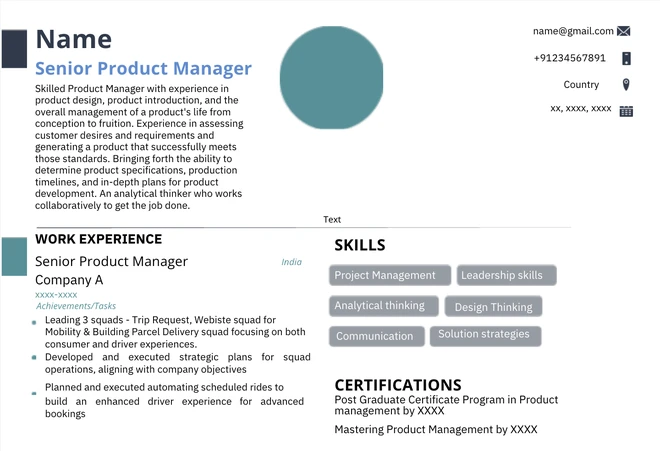
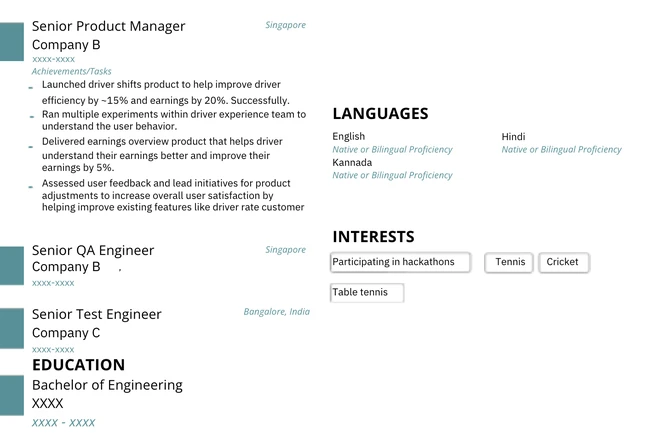
Here’s what makes his resume work:
- Concise: Ashish only details his 2 most recent roles, which are directly related to product management.
- Quantified achievements: He uses numbers to show his impact in his PM roles, whether it’s a success metric or the teams he’s led.
- Certifications: Because his background is not in product management, his PM certifications show that he’s serious about growing in the field.
Room for improvement:
- Layout: The resume could be more ATS-friendly if it had a single-column layout with none of the colored graphic elements.
2.8 Amazon product manager resume example 1
This resume got Jennifer (not real name) an L5 product manager role at Amazon.

Here's our feedback on this resume:
- Layout: Jennifer doesn't have many years of experience, so she starts with her Education section, which is fine, and keeps it to one page.
- Metrics: Jennifer gives specific details about her achievements, e.g.hours saved, size of the budget approved. This helps the recruiter understand her impact.
2.9 Amazon product manager resume example 2
Navi (not real name) is a senior PM at Amazon who successfully transitioned within the company from business development to product management.
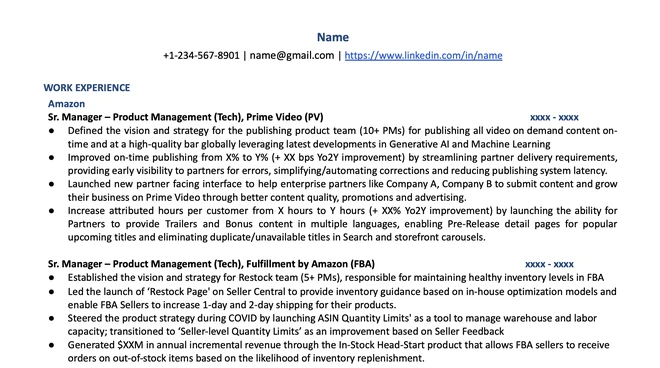
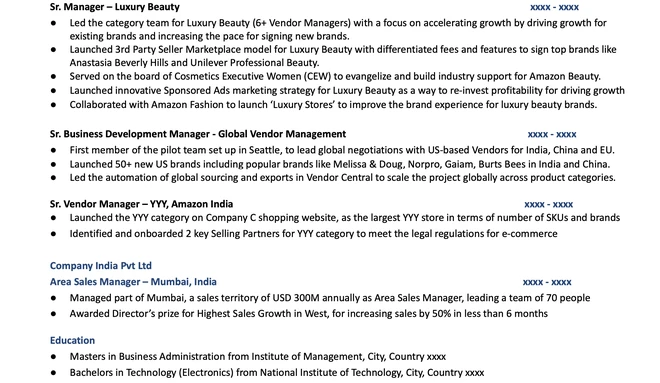
Here’s why we think her resume stands out:
- Simple and detailed: Navi’s resume is only one page long and has a very plain format, allowing her achievements in each of her roles to do the heavy lifting.
- Quantified achievements: She uses numbers to show her impact in previous roles, whether it’s a success metric or the size of the teams she’s led.
- Name-dropping: She name-drops big brands that she’s worked with, showing the scale of her impact.
2.10 Amazon product manager resume example 3
This is the resume that got Shambhavi a senior PM role at Amazon. She’s also currently an expert PM coach on the website.
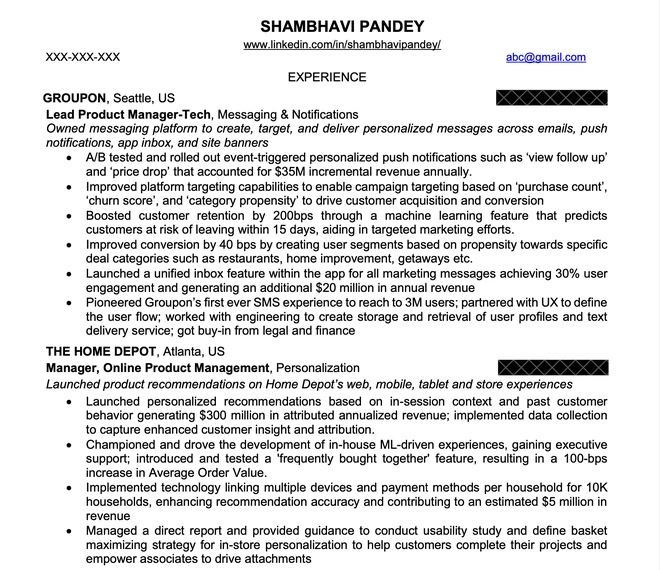

Here’s what makes Shambhavi’s resume stand out:
- Concise and readable: Her one-page resume has a very standard and clean format, making it easy to read.
- Quantified achievements: She ensures that her bullet points include her quantified impact, whether it’s an increase in revenue, customer retention, or product efficiency.
- Cherry-picking information: She keeps her resume concise by choosing to devote the most number of bullet points to her latest and most relevant roles.
2.11 Amazon product manager resume example 4
This is the current resume of Arun (not his real name) as a senior product manager, but it also has the same format that got him his previous role at Amazon.

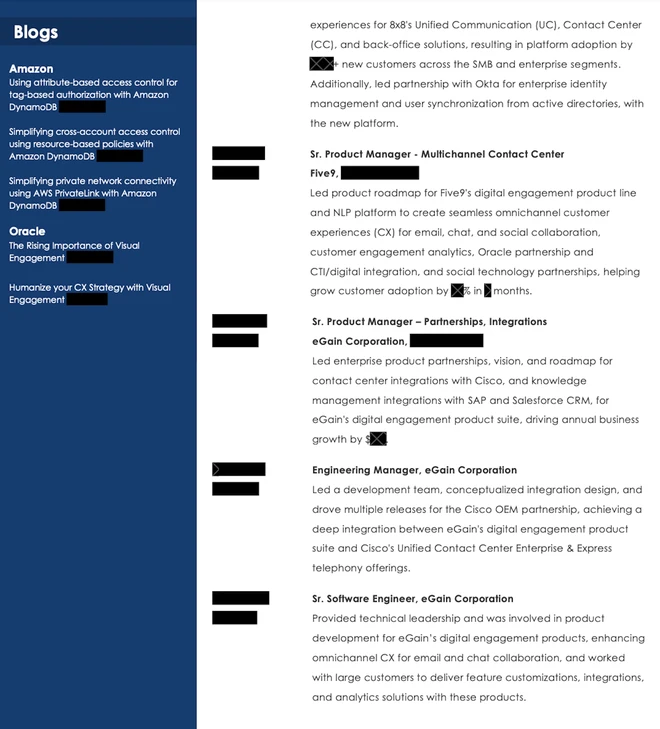
Here's what makes Arun's resume work:
- Quantified achievements: Arun makes sure to include the impact he's made in his previous roles, quantifying impact where possible, whether it’s an increase in revenue, customer retention, or product efficiency.
- Publishing credits: Listing his blog credits is a great way to showcase his expertise.
2.12 Thomson Reuters product manager resume example
This resume got Dhanya (not real name) PM interviews at Thomson Reuters.

Here's what we liked about Dhanya's resume:
- Quantified achievements: Again, Dhanya demonstrates her impact really powerfully, clearly outlining specific and quantified examples.
- Range of skills: Dhanya makes it easy for the reader to see that she has experience using a range of key PM skills (cross-functional collaboration, data analytics, etc.) to have an impact.
- Context: Dhanya went to a top business school in India but it's possible a hiring manager in London might not have heard of it, so she puts it in context for them.
Here are a few things we'd consider changing:
- Certifications: Dhanya lists a range of licenses and certifications. This can help resume screening bots pick up on keywords. However, while some are generally considered important (Scrum Alliance) others less so (LinkedIn, Udacity, etc).
- Accolades: Dhanya has some impressive accolades. However, by including weaker ones (such as a "pat on the back" award) she distracts from the better ones. It's better to cherry-pick.
- Length: Dhanya could consider being more picky about what she includes and fitting it all one one page, as Nicolas did.
3. Product manager resume template↑
We've created a resume template that you can use as a basis or reference point for writing your resume.
Unlike the resumes above, this resume is not a real one. Instead, it's an amalgamation of the many high-quality CVs that candidates have shared with us before going on to work at Google, Meta, and Amazon, etc.
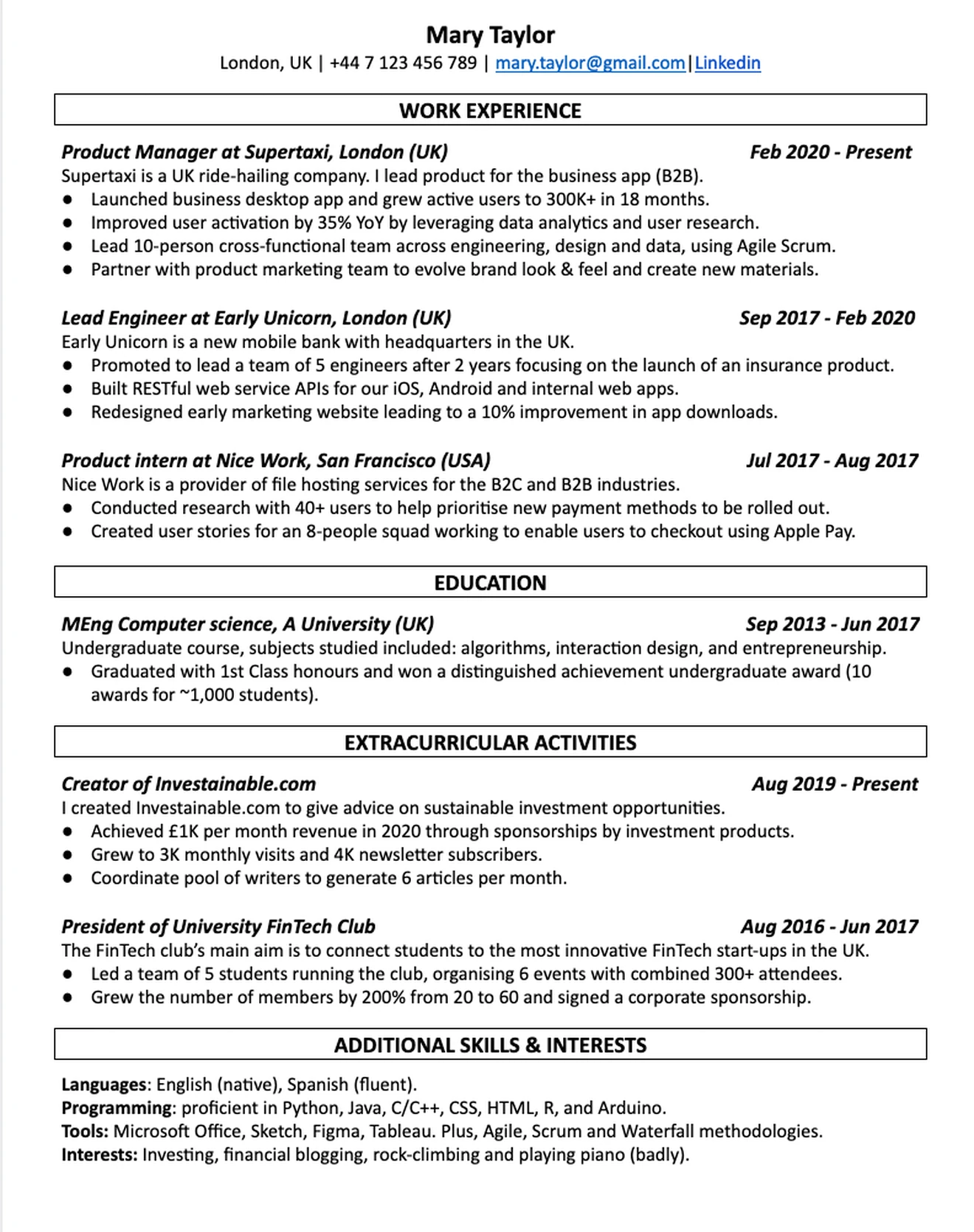
The resume example above should serve as a useful guide when you’re writing yours, and you can even edit it if you like.
Click here to download this PM resume template as a Google doc
Click here to download this PM resume template as a PDF
4. Product manager resume tips (from top recruiters)↑
Before we take you through the step-by-step process of writing your product manager resume, let's look over some key tips and insights that you'll want to keep in mind.
We asked Cody (top tech recruiter, ex-Google now at LinkedIn) and Candace (career and resume expert) what advice they'd give to someone writing a resume to get into FAANG or similar. This is what they came up with:
4.1 Answer recruiters' questions immediately
There are two things that all recruiters and hiring managers want to know immediately: years of role-relevant experience and years of management experience.
So, make it easy for them.
"Us recruiters are lazy. Don't make us dig around for the key info, we want to see if you meet the job requirements in the first 10 seconds!" says Cody.
To do this, you could include some bullet points with this key information at the top of your resume. Which leads us to the next point...
4.2 Consider a non-traditional structure
The layout we recommended in section 5 is the traditional one, perhaps the safest. But it's not obligatory.
Cody prefers using two bullet-point summaries at the top of your resume to pack in the key information and your most impressive career achievements.
"The top of the resume is the prime real estate. Put the shiny bits, your best achievements, up top. That way you've got a better chance of grabbing the recruiter's attention."
This is what it looks like on his resume:

Watch Cody's full explanation of this non-traditional resume format.
4.3 Avoid using design features
You're a product manager, not a product designer, and so there really is no upside to using a fancy resume design. It won't impress recruiters and, in a worst-case scenario, could actually prevent your resume from being properly processed.
"Design features like pictures, columns, photos, etc., can prevent ATS from correctly scanning your resume," says Candace.
You should also avoid including your photo in your resume, as this goes against employment and discrimination laws in most countries, and is another potential problem for ATS systems.
4.4 Include the location you’re open to working at / remote
If recruiters are going to approach you for roles, rather than the other way around, they'll need to know the locations you're available to work at.
If you're willing to relocate for the right role, make that clear in your resume. So, instead of putting "San Francisco" under your name next to your email, maybe you put "Locations: San Francisco| Remote| Hybrid within a 30-mile radius of Bay Area".
4.5 Don't include your address
No recruiter needs to know your street address, and including it can cause problems with data privacy laws. As above, just put your region and an idea of where you're willing to travel to.
4.6 Numbers tell a better story
This is worth repeating again and again: quantify your achievements. All the most effective resumes are packed full of metrics and numbers that put achievements in context.
"This advice is for many careers spanning many industries, we have to tell our story through data and numbers. Words can tell a story but numbers tell it way better," says Cody.
4.7 Use a skills section to include PM keywords
You don't want to jam your resume full of keywords, but with ATS systems increasingly used, it is important to make sure your resume mentions the necessary skills, tools, and technologies.
Candace says that a skills section can be a great place to list all these very efficiently.
"A "Skills" section can help recruiters quickly see if you fit their requirements, and is also a great way to get keywords into your resume."
If the PM role you’re applying for requires experience in specific technologies, you could also consider a ‘technology snapshot’ type section.
5. How to write your product manager resume (section by section)
Now that you’ve seen examples of what you should be aiming for, as well as some key tips, let’s go through the resume-building process, step-by-step.
Step 1: Study the target company and job description
Before you start writing or editing your resume, our tip is that you do some research.
Find the job specification, read it thoroughly, and use it to shape your resume in the following ways:
- Work out what type of PM the job description is looking for. Examine the list of responsibilities and assess whether it falls into one of the four specialization categories we listed above (Core, Growth, Platform, Innovation) or whether it’s describing a “do-everything” type.
- Prepare to adapt your resume’s content accordingly. Focus on the most relevant product skills For example, if you are going for a more technical PM role, cut those public speaking achievements from your extracurricular section and replace them with that hackathon example.
- Zoom in on the most important responsibilities. Search for specific examples from your past that demonstrate experience in doing the same thing or very similar. Find the numbers to back it up where possible, so you’re ready to include this information in the work experience section later on.
- Take note of the language used in the job description. Where appropriate, match specific verbs and phrases.
- Research the company. For example, if you’re targeting a PM role at Meta, you want to make sure that your resume transmits the company’s values too. That might mean including a volunteering activity under Interests to show that you like to "build social value." Follow the same logic if you’re applying for Google or Amazon.
If you’re targeting multiple PM roles, does all this mean you’ll need a different iteration of your resume for each role?
Ideally, yes, but there will be a lot of overlap, and so usually you’ll only need to make a few strategic edits, especially if you can make sure your resume meets the typical job requirements for FAANG companies.
Typical product manager job requirements
We analyzed multiple product manager job offers across 8 different companies: Meta, Google, Amazon, Uber, TikTok, DoorDash, Netflix, and Airbnb.
We aggregated the data to find the most common product manager job requirements for top companies in 2025:
Minimum qualifications
- Bachelor's degree or equivalent practical experience.
- 3-5 years of product management or related industry experience
- Experience in product management, including taking technical products from conception to launch.
- Experience working in a technical environment with cross-functional teams to drive product vision, define product requirements, and guide the team through key milestones.
- Technical understanding, ranging from high-level concepts to detailed aspects of product development.
Preferred qualifications
- Advanced degrees in technical or business fields are a plus.
- 3+ years of experience in specialized areas such as e-commerce, consumer electronics, software development, AI, or machine learning.
- Experience with Agile methodologies, SQL, experiment design, and advanced analytical skills.
- Strong leadership capabilities, with experience in building and mentoring teams.
- Excellent communication skills, with the ability to influence cross-functional teams and senior executives.
Responsibilities
- Define and execute the product vision and strategy, aligning with the company's broader goals and customer needs.
- Lead the ideation, technical development, and launch of innovative products or features.
- Collaborate with engineering, design, marketing, and other departments to ensure successful product outcomes.
- Analyze market trends and user feedback to iterate on product features and roadmap.
- Own the product lifecycle from initial concept through development, launch, and iteration.
- If you don't want to have to tweak your resume for each specific company you're applying to, aim to base your resume around this list of requirements.
Download common product manager requirements as a PDF
Right, once you’ve done the research, you’ll be ready to start writing.
Step 2: Choose a layout
The design of your resume should have one objective: to convey as much information as possible in a way that is clear, easy to digest, and professional. Use our sample resume as your template, and you’ve already achieved that!
Some people add a second objective: to demonstrate strong design skills in order to stand out from the crowd and impress the recruiter.
However, we recommend treading carefully with this. Recruiters for large companies are unlikely to be impressed by a resume’s design; they’re interested in the content. Some might even be put off by a “creative” or unique design.
Another area of debate is length. Should you always stick to just one page?
The answer is no, not necessarily. If you’re an experienced PM, it’s fine to go to two pages, as long as the content is strong and relevant to the role. We can confirm this because many of the candidates who use our coaching service got their FAANG interviews with two-page resumes.
However, if you’ve only been working for a few years, or you’ve recently graduated, we strongly recommend sticking to a single page.
Step 3: Choose your sections
We recommend using the following section layout for a PM resume. The exact titles and order of the sections is open to debate, but we know that this approach works for companies such as Google, Meta, and Amazon, for both junior and experienced candidates.
- Personal information
- Work experience
- Education
- Extracurricular
- Skills & Interests
You may want to tweak the order. For example, if you’ve just graduated or have just a year or two of experience, Google recommends starting with your education section.
Whether or not you stick exactly to our suggested categories, we highly recommend keeping these general layout/design tips in mind:
DO
- Choose a professional-looking font: Size 10-12, black and white. Arial and Calibri are fine
- Save it as a PDF or DOCX
- Use bullet points
- Make sure the formatting is 100% neat and consistent
- Include enough white space that it doesn’t look overcrowded
DON’T
- Include a “summary” or “objective” section at the top (unless you have an unusual profile which needs explaining). Your CV is already a summary, so this just wastes space
- Include references
- Pick an unusual font to try and stand out
Step 4: Start writing
The good news is, you don’t have to get it perfect the first time. A strong PM resume is usually one that is rewritten and tweaked multiple times.
Let’s get into how to write each section.
Personal Information section
This section is not the place to try and impress. Just make sure you get your details across in as few words as possible and avoid mistakes.
Here are some tips to follow:
DO
- Use a bigger font for your name than for the rest of the section to make it stand out
- Include your name, email address, phone number, city/county you live in
- Ideally, include a link to your LinkedIn profile (or Github if you have an engineering background)
DON’T
- Title this section. It’s not necessary in this type of layout, so save the space
- Include a street address, it’s unnecessary and unsafe
- Include a photo, date of birth or gender, unless specifically requested to do so
- Don’t label each piece of information, e.g., “email:”, “tel:”, etc. It’s obvious what they are, so save the space
- Link to personal or portfolio websites here, you can do that lower down
Work Experience section
This is probably the most important part of your resume to get right, and the easiest to get wrong. Many candidates think that their work experience speaks for itself, and simply list their role and a few of their main responsibilities.
However, we recommend a much more powerful approach.
Instead of listing responsibilities, you need to talk about actions. This means starting each bullet point with an action verb.
These verbs should relate to the eight skills from Section 1 that companies look for in PM resumes (Strategy, Design, Coding, Digital marketing, Data analysis, Leadership, Communication, Organization). "Designed," "Analyzed," "Led," or "Built" are good examples of such verbs.
Choosing actions that are relevant to one of the essential product manager skills will also mean that your resume contains the keywords that recruiters (and sometimes Applicant Tracking Systems) will be looking for.
Take a look at our article about product manager resume keywords if you want to know more.
You should also focus on the results of what you did and quantify them as much as possible to highlight the tangible contributions you have made. After all, being a PM is about building things to reach a goal and then measuring the outcome.
There are a few ways you can quantify your achievements. Vaishnaovi (Amazon senior PM) says, “Quantify the impact - number of users, revenue, cost savings. Quantify the complexity - leveraging AI, ML, OR, or scale of business.”
Ex-Google SVP Lazlo Bock talks about a common method for doing this that you might find helpful, called the “X, Y, Z” formula.
Ashwin (ex-Amazon senior PM) recommends following the steps below to summarize your past experience:
- What was your role?
- What did you achieve?
- How did it help your customers and/or the business that you worked for (i.e., the value of your work)?
Finally, balance is important. Because a product manager role is extremely multi-faceted, it’s important to demonstrate a range of skills in the work experience section.
Ready to start writing this section? Use the tips below to keep you on the right track.
DO
- Use reverse chronological order, putting most recent employment at the top
- Use present tense verbs (e.g, "Lead, Develop, Execute") in your current position (except for completed achievements), and past tense verbs for past position (e.g, "Led, Developed, Executed")
- Describe your actions and what they achieved
- Include metrics to quantify what your actions achieved where possible
- Study the language of the job description and where appropriate, match it
- Make sure you’ve naturally included several relevant keywords
- Demonstrate a balance of skills
DON’T
- Be shy and humble, now is not the time!
- Just put your responsibilities
- Be vague
- Go so overboard with numbers that it looks like a math problem. It still needs to be easy to read
- Include lots of buzzwords just for the sake of it
Education section
This section should be extremely concise and clear. Hopefully, your educational achievements can do the talking for you, as all you can really do here is present the necessary information with the right level of detail.
Note that if you have recently graduated and only have internship experiences, this section should follow the Personal Information section. You may also want to go into a bit more detail. Otherwise, you can include it after work experience.
Follow the tips below to make sure you get it just right.
DO
- If you have multiple degrees (e.g., a BA and an MBA), you should write a subsection like the one above for each degree, starting with your highest level of education first (e.g,. your MBA)
- For each degree, include the name of the degree, university, and dates in the headline. If you’re a recent graduate, you can also list any subjects you have taken that are relevant to product management (e.g., design, coding, entrepreneurship, data analysis, etc.)
- List your grades (e.g., GPA) as well as results of other standardized tests you have taken (e.g., SAT, GMAT, etc.) that demonstrate your intellect
- Detail any awards and scholarships you received at university level and most importantly, how competitive they were (e.g., two awards for 1,000 students)
- If you don’t have much tech work experience, you might want to include tech bootcamps (e.g. General Assembly) and link to your projects, or online courses (e.g. Udacity)
DON’T
- Panic if you don't have a degree. You don’t have to have gone to college to get into a FAANG company. Instead, put your high school grades and any relevant educational qualifications you gained after school.
- Include high school experience if you've already graduated.
- Include your thesis/dissertation unless you're a fairly recent graduate, in which case you should summarize the topic in a way that's VERY easy to understand
Extracurricular Activities section
PM roles require a very large breadth of skills, and it can be difficult to demonstrate all of them through your work experience.
The extracurricular section is a great opportunity to cover these skills. It can be particularly useful in demonstrating leadership skills, especially if you haven’t yet had much opportunity to lead in a work situation.
Some candidates (like those in the examples above) ignore the extracurricular section, preferring to use that space to list more work achievements. That's your call, there's no right answer on that.
Note: If you’re applying to Google, you should consider calling this section “Leadership & Awards” to fit in with their recommended CV structure. Obviously, you’ll need to make sure that the content demonstrates those two things.
The extracurricular section is more important for recent graduates than experienced hires, but even for PMs with a lot of impressive work experience to fit in, leaving a bit of space to talk about your personal projects can add a whole new dimension to the “you” on your resume.
Stuck for ideas? Here are a few different types of activities you could write about (not exhaustive):
- Side businesses: if you have set up a side business, you should mention it along with the number of users and / or revenue you have achieved
- Coding projects: if you're not a developer but have built simple web apps to teach yourself to code, this is the place to mention it
- Writing / design: if you enjoy writing or design and have a blog where you show your work, share it in this section
- Meetups / events: be sure to mention if you have organized meetups or events in the past, as this is a great way to highlight leadership skills
- University clubs / sports teams: if you are a recent graduate and have held a position in a university club (e.g. Entrepreneur club) or were part of a sports team, then this is also a great thing to include
If you don't have any recent and relevant extracurricular activities worth including, leave out this section and fill the space by adding more content to the work experience section. After all, if it’s not going to make you shine, there’s no point including it.
Ready to write the extracurricular section? Here are the remaining tips you need to know.
DO
- Use this section to demonstrate relevant skills, such as leadership
- As with work experience, try and include actions and achievements, and quantify them
DON’T
- Put a hyphen in the title: "Extracurricular” is all one word
- Capitalize “university” unless you’re using it as a proper noun (e.g, “Oxford University”)
- Give very outdated examples. If you graduated 7+ years ago, there shouldn’t really be university examples there
Additional Skills & Interests section
Product managers need to be adept at using a wide range of tools, methodologies, and technologies. This section gives you the opportunity to list yours.
Other ideas for this section worth including:
- Foreign languages (employers generally look favorably on them)
- Any programming languages (e.g., HTML, CSS, JS, Python, etc.)
- Relevant tools (e.g., Jira, Sketch, Tableau, etc.)
- Product management methodologies that you’re familiar with
Under “Interests,” listing a few hobbies is an opportunity to show some more of your personality. It’s also the only place where you might be able to squeeze in a drop of humor (as in the example above), but we advise against that unless it comes easily.
However, if you feel you’ve already covered your interests in Extracurricular (or if you’ve been so career-focused that you simply don’t have any!), you can change this section to just “Additional skills”.
DO
- List things in sentences rather than lots of bullets which takes up too much vertical space
DON’T
- Include generic, uninteresting things that everyone likes doing, like “watching Netflix” or “hanging out with friends,” as hobbies
Step 5: Proofread and get feedback
Attention to detail is a core PM skill, so don’t skip this step!
Use the grammar checking tool in Word or Google Docs, and proofread until it’s perfect. Multiple reviews and tweaking after the initial proofread can easily create new hard-to-spot errors. The only solution is to proofread again.
We recommend saving as a PDF or DOCX file unless the job description says otherwise, and checking it opens properly (with the correct formatting) on a Mac or PC.
Receiving feedback is also important. Share it with a friend or partner and they’ll be very likely to see mistakes that you haven’t noticed. Of course, if you can share it with an experienced product manager, that’s even better.
DO
- Proofread from top to bottom and then read it in reverse to check spelling
- If you’ve tweaked it, proofread again before sending
- Check the file opens properly on Mac and PC
- Get feedback on it before sending
DON’T
- Send it with typos. Your resume is your product!
6. Your PM resume checklist↑
Almost ready to send your resume? Use this checklist to make sure you’re following the best practices we’ve recommended above.
General
- Have you worked out which of the 4 main types of PM the job description is looking for, and does your resume match it?
Layout
- Is it just one page? If not, do you have the experience to merit 2 pages?
- Is the formatting 100% consistent and neat?
- Is there enough white space to breathe?
Personal Information
- Have you checked that your contact details are correct?
Work Experience
- Have you talked about your actions rather than your responsibilities?
- Have you quantified the impact of your actions?
- Have you demonstrated the 8 PM skills? (strategy, UX design, coding, marketing, data analytics, leadership, communication, organization)
- Have you got the tenses correct?
Extracurricular
- If you graduated >5 years ago, are your examples post-university?
Skills & Interests
- Have you listed all the programming languages and tools you’re familiar with?
- Do your interests make you stand out from the crowd in some way?
Proofreading and feedback
- Have you proofread it since you last edited it?
- Have you received any feedback on your resume and updated it?
- Have you saved it as a PDF to make sure it displays correctly on all devices?
Did you say “Yes” to every question in the checklist? Well done! If you’ve used all the tips in this article, then your resume should be in good condition and will give you a fighting chance of getting that interview.
We also recommend watching the video below to make sure you didn't make any of these common product manager resume mistakes:
7. Is your PM resume truly outstanding?
If you're going for one of the top tech jobs, having a resume that's "fine" may not be enough. To get your product management resume from "fine" to "outstanding" usually requires feedback from someone who really knows their stuff - as in an ex-recruiter or manager at one of the top companies.
We know it's hard to get access to those types of people. That's why we've created a resume review service that allows you to get immediate feedback on your resume with a top recruiter/coach of your choosing. Take a look at our PM resume experts.






